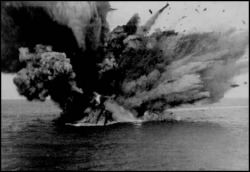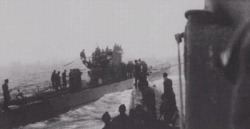| Silent Hunter II Interview by Leonard "Viking1" Hjalmarson |
||||
|
CSIM: A related question is the ability of both sides to shift tactics in response to changing technology and tactics on the other side. For example, when the U Boat missions were becoming increasingly suicidal in the face of Allied air power, the acoustic homing torpedo finally made its debut. U Boat captains were ecstatic for a short time…. Can you comment on the fluid tactics of the war and how these are represented in Silent Hunter II? A: As in all simulations, the more historical elements that are modeled accurately, the closer the final product should mirror reality. The fluidity of the tactics was necessitated by the change in the advantages and disadvantages for both sides as the battle dragged on. Our intent in Silent Hunter II is to recreate enough of these changes so that the player must change tactics in ways that are similar to his/her historical counterparts. To directly address the issue of the German Acoustic torpedo (Zaunkonig or T5), this torpedo is modeled in Silent Hunter II and is introduced to operational boats in September 1943.
Unfortunately, the T5 suffered from several faults resulting in a poor success rate (77 definite hits out of 700 torpedos shot). The U-boats, in their first wolfpack attack using the T5 (Convoy ONS 18/ON 202), greatly overestimated the effectiveness of the T5. Even so, the T5 produced swift countermeasures by the British and within weeks decoys imitating propeller noise were being towed behind all North Atlantic escorts. Silent Hunter II recreates both the T5 and the Allied countermeasures. CSIM: Will you model German sonar and hydrophones? A: Yes CSIM: Will it be possible to visually detect schnorchel heads? A: Yes CSIM: Simulation designers are constantly making trade offs for the sake of playability, and inevitably either realism or game play has to take a hit. How do you approach the period of history when U Boat missions were suicidal from the game play standpoint? A: This has always been a major concern of ours in Silent Hunter II. Sim fans can be divided into two distinct groups: the casual gamer and the hardcore simulation fan. The former wants action and high scores, the later realism and historical accuracy. We asked ourselves, "How do you satisfy both with the same game?" Our answer was to effectively create two games through difficulty levels and realism settings both in the tactical and the campaign game. Silent Hunter II will offer realism settings in campaign mode for a variety of options including: amount of convoy traffic, effectiveness of Allied and German weapons and countermeasures, and the level of improvement in Allied tactics and strategic planning. At the easy level, a player will find lots of targets and opportunities for tonnage. At the most realistic level, the battle should be as challenging and "suicidal" as it was for real "Herr Kaleu". But after 1943 it will be very, very tough.
 CSIM: From the tactical standpoint the single most powerful tactic of the Type 7 boats was the Wolf Pack. This necessitates the use of some kind of communications: radio or morse. What will we see in SH II? A: It will be simple but it will be there. Silent Hunter II will have a radio room where radio communications are received from BdU, encoded short-wave messages can be transmitted. Messages can be sent to BdU or specific U-boats. All U-boats can eavesdrop on all messages sent. CSIM: Will it be possible to use radio to request resupply of torpedoes from a type XIV while on patrol? A: Yes CSIM: How will the use of the Wolf Pack look in multiplayer cooperative missions, and will these be available to the player? Can you sketch what this mission would look like from the players perspective in terms of tactics and command? (Use of comms etc).

 HMS Barham. A: Picture a convoy moving A to B. The players log on til the wolfpack is full. We will provide reliable communication for the purpose of multiplay. At a safe distance from the action. When ready to converge the players will be able to send messages. Players will also have a map showing the position of the other ships. We'd like to keep everything running through the radio room though a real chat mode will be available for non-gameplay related communications. |
 U 505. Photo by Tim Burton. CSIM: In our earlier interview you mentioned a variety of mission types, including mining using the TMB "seabed" mine. What is the challenge in these missions and why are they included? A: Stealth missions, sneaking around. These missions won't appeal to all, but some players love this kind of thing. So, you sneak in to or just outside of a harbor and start placing mines. You may have to also avoid shore batteries (this feature may not make it in). These missions were also a major role played by the U-boats early in the war. Leaving them out would distort the role of the U-boat early in the campaign and eliminate a very different kind of challenge that a real U-boat commander experienced. CSIM: One of the tactics employed by the Kriegsmarine was resupply while at sea with special "milk cow" resupply boats. Are these modeled in Silent Hunter II and will we have to rendezvous while on extended missions? A: You may meet such a ship on the way to another zone. So, the rendezvous won't be a feature in itself or the goal of the mission, but if you receive orders to move to a new zone, you may have to successfully resupply and refuel on the way.
 The Milk Cows were U-boats of type XIV and their role was to support the operating VII and IX fighting U-boats by delivering supplies and ammunition. These boats were successful while operating off of the US coast where their location 1000km out of New York permitted the smaller VIIC Atlantic boats to operate in US waters. They were similarly successful in the Caribbean in 1942, but vastly improved allied radars and better air coverage of the Atlantic eliminated them during 1943, and 14 other XIVs were cancelled.
A: The rendezvous will be represented in the 3D world by a real milch cow. The player will be forced to move within close range of the sub and must stay on the surface for a sufficient period of time for refueling and resupply. This is part of the danger of the operation. Rendezvousing with a milch cow will be the only way your U-boat can refuel at sea and extend its mission. If the rendezvous is unsuccessful, it could force a return to port or potentially leave you stranded in the Atlantic!
 Photo Courtesy of Lester Palifka. CSIM: Its hard to imagine a graphics environment beyond that of the first Silent Hunter. What are your goals graphically? And will Silent Hunter II be written for Glide as well as D3d? A: Silent Hunter achieved its "look" by getting everything we possibly could out of the technology available. For example, through careful selection and reuse of colors we were able to squeeze every last ounce out of the 256 color palette, creating a vibrant and dynamic look that belied the actual capabilities of the hardware. With the new 3D cards available, a lot of these limitations have been removed allowing for far more realistic visuals than we could even imagine when developing Silent Hunter over 3 years ago. Even though Silent Hunter was internally a "3-D" game, its visual representation of ships and aircraft using sprites locked us into viewing from one "plane". This was realistic in that real sub crews were limited to this perspective as well, but it wasn't as satisfying to players who wanted to see the action from a variety of angles. Silent Hunter II will be fully 3-D, giving the player many more views from which to enjoy the action. Glide support will not be included. Support will be using DirectX 6 and Direct3D. Go to Part III
|
|||
|
© 1997 - 2000 COMBATSIM.COM, INC. All Rights Reserved. Last Updated February 10th, 1999 |
||||


